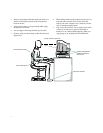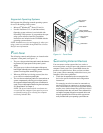
Introduction 1-11
Chapter 1
Introduction
Dell
®
PowerEdge
®
2100/180 and 2100/200 systems
are high-speed, upgradable server systems designed
around the Intel
®
Pentium
®
Pro family of micro-
processors. The PowerEdge 2100 systems provide both
Extended Industry-Standard Architecture (EISA) and
high-performance Peripheral Component Interconnect (PCI)
expansion slots to allow for future expansion of your system.
This chapter describes the major hardware and software
features of the computer, provides information about the
indicators and controls on the computer’s front panel, and
discusses connecting external devices to the computer.
System Features
The PowerEdge 2100/180 and 2100/200 systems offer
the following major features:
• A Pentium Pro microprocessor with an internal oper-
ating frequency of 180 megahertz (MHz) in the
PowerEdge 2100/180 and 200 MHz in the PowerEdge
2100/200. The external bus speeds of the PowerEdge
2100/180 and PowerEdge 2100/200 are 60 MHz and
66 MHz (respectively).
NOTE: The microprocessor module is installed in a
zero insertion force (ZIF) socket on the system
board, allowing you to upgrade to a faster, more
powerful microprocessor as your processing needs
increase.
The Pentium Pro microprocessor module includes
separate processor and cache memory chips
(256kilobytes [KB]) in a single module. The
Pentium Pro microprocessor features Dynamic
Execution, which combines three processing
techniques:
— Multiple branch prediction—the processor
anticipates jumps in the instruction flow and
where the next instruction can be found in
memory.
— Data flow analysis—the processor determines
which instructions are ready for processing and
which are waiting for results from other instruc-
tions. The processor then schedules instruction
execution to minimize idle time.
— Speculative execution—the processor executes
instructions according to the optimized schedule
for maximum processor performance and
efficiency.
• Cache memory (internal to the Pentium Pro module)
that provides 256 KB of static random-access mem-
ory (SRAM). Cache memory enhances the speed of
many microprocessor operations by storing the most
recently accessed contents of system memory.
• A minimum of 16 megabytes (MB) of system mem-
ory, upgradable to a maximum of 512 MB by
installing combinations of 16-, 32-, and 128-MB
buffered, extended data output (EDO), dual in-line
memory modules (DIMMs) in the four DIMM sock-
ets on the system board.
The buffered 72-bit wide EDO DIMMs installed in
PowerEdge 2100 systems support error correction
code (ECC) to check for and correct memory errors.
ECC is performed by the memory controller in the
system chip set.


















